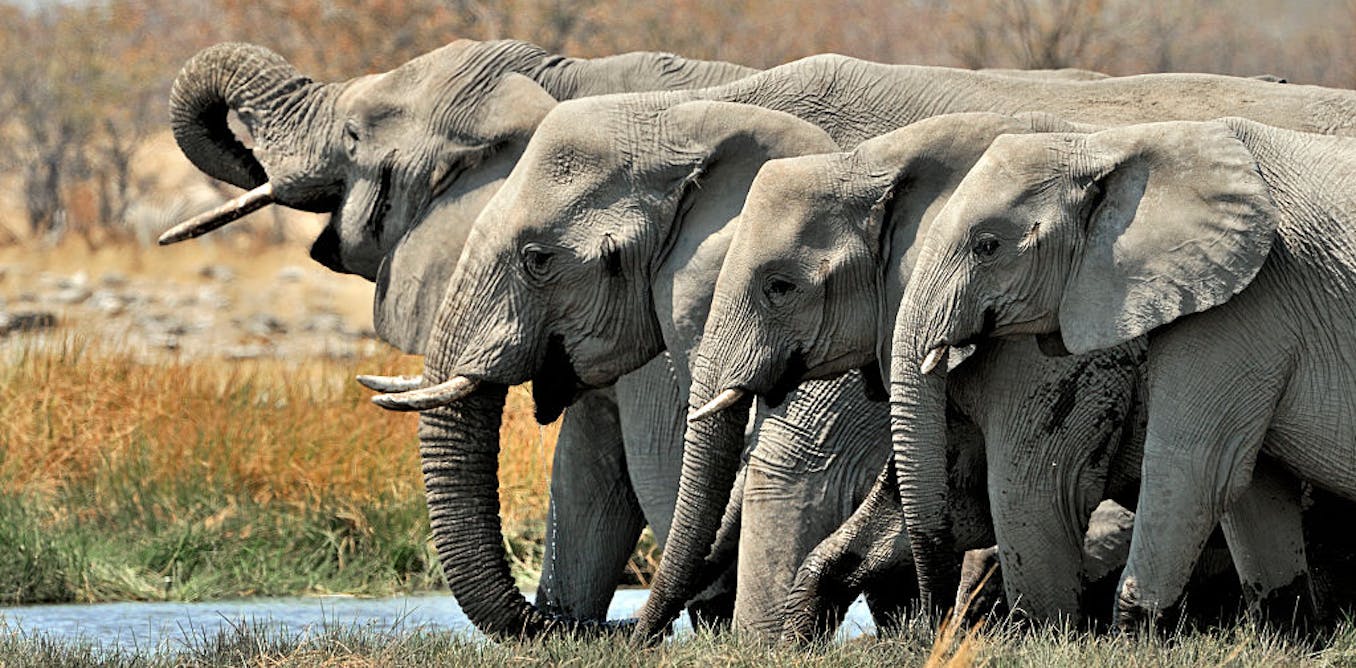In elephant family groups made up of related females and their young, it is clear that the animals produce vocal sounds to coordinate action. This happens when it’s time to leave a waterhole, for example. The matriarch or dominant female steps away from the waterhole and turns to the direction she intends to move in. Then she flaps her ears as she makes a short call referred to as the “let’s go” rumble.
What follows is a highly coordinated “conversation” of sorts. The female elephants in the group add their own rumbles, each waiting for the previous individual to finish what it has to say first.
Elephants coordinate action so that they can remain together (at least within acoustic range), while moving to the next resource. It is safer for females and their offspring to travel as a group to protect their young from potential predation.
Male elephants also live in groups, often referred to as bachelor herds. But it’s never been clear how they coordinate their actions. Previous research using camera trap data seemed to show that subordinate males simply followed older males to resources.
Ever since my husband and I worked for the Namibian government from 1992-1995, we have been returning to Mushara waterhole to study the resident elephants. Since 2004, I have brought a team of researchers to help me, and we have returned every dry season to follow the lives of known individual elephants to learn about their group dynamics, coordination and communication.
Our observations of a group of male elephants in Etosha showed that they use the same vocal coordination as females to trigger the action of leaving the waterhole. And the three elephants that most often initiated the “let’s go” rumbles were highly socially integrated. One of them was the most dominant in the group.
This active coordination of male movements, triggered by vocalisations, has never been documented before. It was also surprising because previously it was thought that male groups didn’t have tight social bonds.
Our findings suggest that male elephant society is much richer than previously thought.
Recording elephants in Namibia
Our study of elephant “let’s go” rumbles at Mushara waterhole started in 2005. We know the individual animals and their hierarchy. We recorded their vocalisations and behaviour when they left the waterhole, noting which individuals made the calls and in what order. Each one’s social status and the “signature” structure of its call was also documented.
The calls are infrasonic – humans can’t hear the fundamental frequency but our high-tech microphones could pick them up so we could analyse them later.
Male elephant sounds recorded by extremely sensitive microphone.
The recordings and observations showed that older males invited younger ones to follow them when they left the waterhole, in the same way as females do. The senior male elephant gave a “let’s go” rumble and then each male contributed its own response in a highly coordinated, synchronised fashion.
The involvement of many group members in the “vocal bout” suggests a consensus decision-making process about the timing and direction of the group departure, even though a lead individual initiated the event.
Even more fascinating is that the responses had a musical quality, in the sense that each elephant manipulates its larynx to modify the sound it makes relative to the sound it hears from another elephant. We didn’t expect this and are looking into it more deeply.
Male elephant society
Another reason this finding is exciting is that it provides further evidence that coming-of-age males have a social resource that they can access after they leave the security of family.
Male elephants grow up in a highly social environment within family groups. As youngsters, they are always around their brothers, cousins and other extended family. Once they leave their families at the age of 12-15 years, they suddenly find themselves in a whole new social situation – alone until they can forge ties with other independent males and groups of males within the population.
This isn’t always a straightforward process, and often older males aren’t so interested in dealing with socially needy young males. But a few of the older, social bulls in the Mushara region of Etosha National Park do behave as if they have an interest in taking these young males under their wing.
Caitlin O’Connell-Rodwell, Author provided (no reuse)
Mentorship is critical for young male elephants. They seek out elders and young adults that are inclined to look after their wellbeing. It is truly remarkable to witness these “mentor” characters, and to follow their growth as leaders after coming out of known families that we’ve been watching for decades.
There may be safety in numbers for males, but since predation isn’t as much of a factor, the likely goal of keeping the group together may be to better defend a resource, or simply to remain close to bonded individuals when having to forage a great distances from water resources.
Our study highlights the role of socially integrated males in leading and coordinating group activities. It also provides further evidence that the behaviour of these individuals is crucial for group cohesion.
Male elephant society is steeped in ritual. This is something I emphasise in my books, Elephant Don and Wild Rituals. This study demonstrates further that male elephant society is even more sophisticated than we had previously imagined.
Elephant communication
This study and another recent study (showing that elephants have names for each other) opens the door to a whole new realm of questions regarding the use of nouns (naming) and verbs (“let’s go”), thereby forming a sentence.
Read more:
African elephants address one another with name-like calls − similar to humans
The study also provides further evidence of dialects, as the “let’s go” rumbles we recorded in Etosha look very different structurally than previously published rumbles in parks in east Africa.
We intend to further explore the structure of these coordinated vocalisations among both male and female groups of elephants, as well as the extent of vocal manipulation and coordination in different populations.




